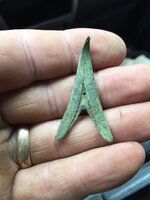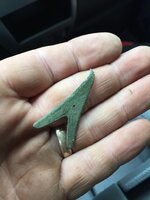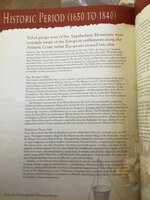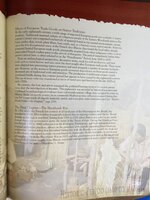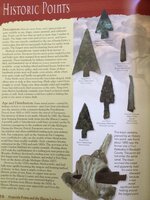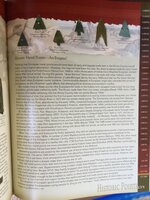Navigation
Install the app
How to install the app on iOS
Follow along with the video below to see how to install our site as a web app on your home screen.
Note: This feature may not be available in some browsers.
More options
You are using an out of date browser. It may not display this or other websites correctly.
You should upgrade or use an alternative browser.
You should upgrade or use an alternative browser.
Copper Arrowhead, but how old?
- Thread starter Scrappy
- Start date
Charl
Silver Member
That is Native. Here in southern New England, it's a known style, but not the most common style. What Mark posted shows the more common style here, which is a triangle, or triangle with perforation.
The age depends on where you found it in the Northeast, because the tribes persisted for longer period of time in some areas then in others. For instance, if that were found in southern New England, it would likely be from the 17th century, no later then King Philip's War of 1675-76. But, natives lived freely longer in New York and Pa., for example, and there it could date to the 1700's. Either way, it can, and most likely is, more then 200 years old, and if from the early 1600's, could be closer to 400 years old.
The English traded brass and copper kettles to natives here, and the men cut that thin sheet metal up and made points out of them. I love finding trade points where I live, but only have two as personal finds. I think that is a great find.
The age depends on where you found it in the Northeast, because the tribes persisted for longer period of time in some areas then in others. For instance, if that were found in southern New England, it would likely be from the 17th century, no later then King Philip's War of 1675-76. But, natives lived freely longer in New York and Pa., for example, and there it could date to the 1700's. Either way, it can, and most likely is, more then 200 years old, and if from the early 1600's, could be closer to 400 years old.
The English traded brass and copper kettles to natives here, and the men cut that thin sheet metal up and made points out of them. I love finding trade points where I live, but only have two as personal finds. I think that is a great find.
Scrappy
Gold Member
- Mar 6, 2014
- 9,204
- 14,019
- 🥇 Banner finds
- 7
- Detector(s) used
- Minelab CTX 3030 & XP Deus
- Primary Interest:
- Other
- Thread starter
- #5
Here's some documented info...
Nice find!
Never seen one exactly like that before.View attachment 1482353View attachment 1482354View attachment 1482355View attachment 1482356
Excellent info, great reading and definitely helpful. Thanks so much for the help.
sawmill man
Hero Member
I dont know but it dos look like it would come from a weather vain.
Scrappy
Gold Member
- Mar 6, 2014
- 9,204
- 14,019
- 🥇 Banner finds
- 7
- Detector(s) used
- Minelab CTX 3030 & XP Deus
- Primary Interest:
- Other
- Thread starter
- #7
That is Native. Here in southern New England, it's a known style, but not the most common style. What Mark posted shows the more common style here, which is a triangle, or triangle with perforation.
The age depends on where you found it in the Northeast, because the tribes persisted for longer period of time in some areas then in others. For instance, if that were found in southern New England, it would likely be from the 17th century, no later then King Philip's War of 1675-76. But, natives lived freely longer in New York and Pa., for example, and there it could date to the 1700's. Either way, it can, and most likely is, more then 200 years old, and if from the early 1600's, could be closer to 400 years old.
The English traded brass and copper kettles to natives here, and the men cut that thin sheet metal up and made points out of them. I love finding trade points where I live, but only have two as personal finds. I think that is a great find.
Excellent info and thanks for taking the time to explain. I'm located (this weekend) on Eastern Long Island. Although the Culture lasted out here for a while, most Natives were pushed out from disease and colonization by about 1660. The few remaining Native Americans from several tribes were put on a reservation by 1703. The immediate area was where I found the point was settled in 1640 where the Native population was quickly dispersed and moved East to Montauk.
Wow, most certainly one of my favorite artifacts!!
Charl
Silver Member
Excellent info and thanks for taking the time to explain. I'm located (this weekend) on Eastern Long Island. Although the Culture lasted out here for a while, most Natives were pushed out from disease and colonization by about 1660. The few remaining Native Americans from several tribes were put on a reservation by 1703. The immediate area was where I found the point was settled in 1640 where the Native population was quickly dispersed and moved East to Montauk.
Wow, most certainly one of my favorite artifacts!!
Thanks for that location information. I think you can be pretty certain that it does date to the 1600's!
Charl
Silver Member
Excellent info and thanks for taking the time to explain. I'm located (this weekend) on Eastern Long Island. Although the Culture lasted out here for a while, most Natives were pushed out from disease and colonization by about 1660. The few remaining Native Americans from several tribes were put on a reservation by 1703. The immediate area was where I found the point was settled in 1640 where the Native population was quickly dispersed and moved East to Montauk.
Wow, most certainly one of my favorite artifacts!!
Also, that's the same culture area as the tribes living in southern New England. The Montauks, for instance, were generally subservient to, considered vassals of, the more powerful Narragansett of mainland Rhode Island. They were expected to pay tribute to, in the form of belts of wampum, to the Narragansett sachems during the 17th century. All that changed, of course, once the Narragansett, and other New England tribes, were defeated in King Philip's War.
Excellent info and thanks for taking the time to explain. I'm located (this weekend) on Eastern Long Island. Although the Culture lasted out here for a while, most Natives were pushed out from disease and colonization by about 1660. The few remaining Native Americans from several tribes were put on a reservation by 1703. The immediate area was where I found the point was settled in 1640 where the Native population was quickly dispersed and moved East to Montauk.
Wow, most certainly one of my favorite artifacts!!
Greetings Charlie, out of curiosity I have a question, as it pertains to that local types.
Does that local type have only to do with the general shape of that particular point, or does it include the rolled over edges being bent and hammered down for reinforcement of the blade. To put it another way, are many of that point type without the folded over reinforcements?
Charl
Silver Member

Greetings Charlie, out of curiosity I have a question, as it pertains to that local types.
Does that local type have only to do with the general shape of that particular point, or does it include the rolled over edges being bent and hammered down for reinforcement of the blade. To put it another way, are many of that point type without the folded over reinforcements?
Hi Mark. Jeff Boudreau, in his "A New England Typology of Native American Projectile Points"(2008) shows two examples with the same shape, a triangle with deeply indented base, and a perforation above the top of the indentation. Those indentations are very common in the more common triangles with 3 straight edges, probably more then triangles without perforations, and they are interpreted as aids in hafting, or to make it possible to carry the unmounted points on a strand. It looks like the point in this thread has a perforation, but it looks much smaller in diameter then the other examples I've seen of either type. But, overall, I have not seen enough examples of this type, or held any in hand, to answer your question regarding reinforcement.
So, I'm speaking of the general shape. In the examples I'm looking at in Boudreau's typology, I do not see any folding over, so I'm guessing without folding over for reinforcement is the more common occurance. Beyond what I've seen illustrated, I just don't have enough experience with 17th century trade points. Almost all are native made from cut up brass and copper kettles, and by the second half of the 1600's, Native Americans had become highly skilled metal workers.
Last edited:
Thanks for the reply Charlie, I have seen quite a few historic copper points but I've just never seen one with the edges folded over like that. The deep indentation between the barbs certainty makes for a much more attractive point, and looks like it would aid in haftiing as you state, and provide more stability on the shaft as well. My guess is that it's much more rare, as you suppose, the folding over that is.
Thanks again for the information!
Thanks again for the information!
Riverbum
Sr. Member
Hello Scrappy,
I hope to find just ONE metal point for my collection, but nothing after 50 years of searching. A lot of them were made from barrel hoop metal (iron) Indians found during the 1700-1890 along the trails moving west......not many left due to natural rusting. IMO, This one in the picture kind of reminds me of a fence post top ornament, although I'm NO EXPERT by any means.
I hope to find just ONE metal point for my collection, but nothing after 50 years of searching. A lot of them were made from barrel hoop metal (iron) Indians found during the 1700-1890 along the trails moving west......not many left due to natural rusting. IMO, This one in the picture kind of reminds me of a fence post top ornament, although I'm NO EXPERT by any means.
Charl
Silver Member
In this older thread, there are a couple of broken Ct. examples that are similar in form(the two in the bottom row) to the example from this thread:
http://www.treasurenet.com/forums/fur-trade-artifacts/200213-brass-kettle-points.html
Here are the most common type, from my own collection, and from 17th century Iroquois village sites in New York:
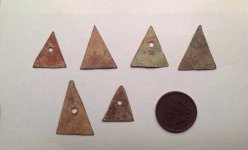
http://www.treasurenet.com/forums/fur-trade-artifacts/200213-brass-kettle-points.html
Here are the most common type, from my own collection, and from 17th century Iroquois village sites in New York:

Old Pueblo
Bronze Member
Id agree with a 1600s date. ANd I have no idea, but it had to have been European made.
Scrappy
Gold Member
- Mar 6, 2014
- 9,204
- 14,019
- 🥇 Banner finds
- 7
- Detector(s) used
- Minelab CTX 3030 & XP Deus
- Primary Interest:
- Other
- Thread starter
- #16
Thanks for all the thought put into the responses. I really appreciate it. I really hope to someday get into some more NA artifacts so I can post more here and not just lurk. Lol
Wampum
Full Member
I've dug dozens of native made and European made from a single NY site 1610-1620 and none look like that. Really nice piece! Because of the exactness of the seam and edges and the hole is likely die punched with no rough edges like where an awl would have gone through I would say it was European made. Maybe made for spearing and grabbing beavers or the like due to the long Barb's.
Top Member Reactions
-
 3498
3498 -
 1983
1983 -
 1929
1929 -
 1194
1194 -
 1117
1117 -
 1021
1021 -
 873
873 -
 842
842 -
 820
820 -
 796
796 -
 744
744 -
 680
680 -
 579
579 -
 567
567 -
 501
501 -
 449
449 -
 429
429 -
E
415
-
 405
405 -
 392
392
Users who are viewing this thread
Total: 2 (members: 0, guests: 2)
